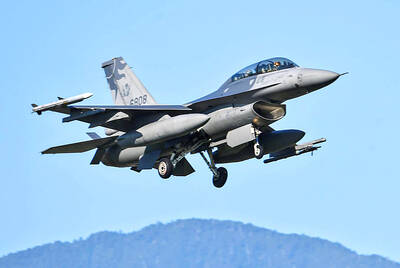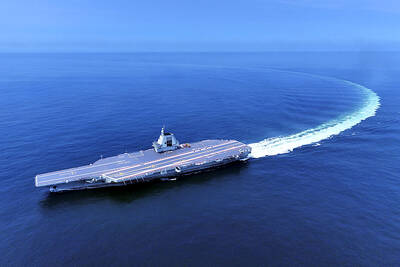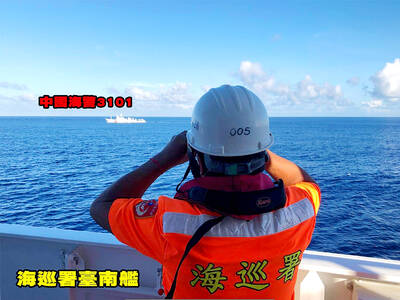The computer-aided war-games portion of the annual Han Kuang military exercises will be held next month and the drill will focus on a simulation of a battle group of the Liaoning, China’s first aircraft carrier, attacking Taiwan’s east coast, the Ministry of National Defense said yesterday.
Major General Mei Chia-shu (梅家樹), vice director of the ministry’s Operations and Planning Division, told a press conference that the computer-aided war games are to take place from May 19 to 23 to examine the military’s joint homeland defense capability.
The war games will simulate a Chinese force launching full-scale warfare against the nation, with its Liaoning aircraft carrier battle group moving to waters east of Taiwan and attacking the nation from the sea, the ministry said.
The nation’s new weapon systems, including AH-64 Apache helicopters, Thunderbolt-2000 multiple launch rocket systems and P-3C anti-submarine warfare patrol aircraft, will join the computer-aided drill, the ministry added.
Mei said the goal of the computer-aided war games is to practice difficult joint arms warfare scenarios and strengthen the military’s joint warfare capability.
The scenarios and result of the war games are to serve as a reference for live-fire exercises scheduled to take place in September.
Meanwhile, Pai Chieh-lung (白捷隆), a human resources official at the ministry, said the ministry’s recruitment plan this year has gone well and the recruitment target has been met.
He said the ministry planned to recruit 5,920 personnel, but as of Sunday 8,634 people have already signed up to become volunteer soldiers.
The government has been offering incentives for young people to pursue a military career. On Jan. 1, the government raised monthly allowances for volunteer soldiers and non-commissioned officers by between NT$2,000 and NT$4,000.
Taiwan plans to shift to an all-volunteer force by 2017. It originally planned for the transition to be completed by next year, but pushed the date back due to lower-than-expected recruitment numbers.

The first two F-16V Bock 70 jets purchased from the US are expected to arrive in Taiwan around Double Ten National Day, which is on Oct. 10, a military source said yesterday. Of the 66 F-16V Block 70 jets purchased from the US, the first completed production in March, the source said, adding that since then three jets have been produced per month. Although there were reports of engine defects, the issue has been resolved, they said. After the jets arrive in Taiwan, they must first pass testing by the air force before they would officially become Taiwan’s property, they said. The air force

The Chinese People’s Liberation Army Navy’s (PLAN) third aircraft carrier, the Fujian, would pose a steep challenge to Taiwan’s ability to defend itself against a full-scale invasion, a defense expert said yesterday. Institute of National Defense and Security Research analyst Chieh Chung (揭仲) made the comment hours after the PLAN confirmed the carrier recently passed through the Taiwan Strait to conduct “scientific research tests and training missions” in the South China Sea. China has two carriers in operation — the Liaoning and the Shandong — with the Fujian undergoing sea trials. Although the PLAN needs time to train the Fujian’s air wing and

The Coast Guard Administration (CGA) yesterday said it had deployed patrol vessels to expel a China Coast Guard ship and a Chinese fishing boat near Pratas Island (Dongsha Island, 東沙群島) in the South China Sea. The China Coast Guard vessel was 28 nautical miles (52km) northeast of Pratas at 6:15am on Thursday, approaching the island’s restricted waters, which extend 24 nautical miles from its shoreline, the CGA’s Dongsha-Nansha Branch said in a statement. The Tainan, a 2,000-tonne cutter, was deployed by the CGA to shadow the Chinese ship, which left the area at 2:39pm on Friday, the statement said. At 6:31pm on Friday,

STRIKE: Some travel agencies in Taiwan said that they were aware of the situation in South Korea, and that group tours to the country were proceeding as planned A planned strike by airport personnel in South Korea has not affected group tours to the country from Taiwan, travel agencies said yesterday. They added that they were closely monitoring the situation. Personnel at 15 airports, including Seoul’s Incheon and Gimpo airports, are to go on strike. They announced at a news conference on Tuesday that the strike would begin on Friday next week and continue until the Mid-Autumn Festival next month. Some travel agencies in Taiwan, including Cola Tour, Lion Travel, SET Tour and ezTravel, said that they were aware of the situation in South Korea, and that group